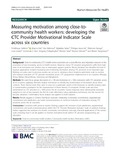| dc.contributor.author | Vallières, Frédérique | |
| dc.contributor.author | Kok, Maryse | |
| dc.contributor.author | Mahmud, Ilias | |
| dc.contributor.author | Sarker, Malabika | |
| dc.contributor.author | Jeacocke, Philippa | |
| dc.contributor.author | Karuga, Robinson | |
| dc.contributor.author | Limato, Licia | |
| dc.contributor.author | Kea, Aschenaki Z. | |
| dc.contributor.author | Chikaphupha, Kingsley | |
| dc.contributor.author | Sidat, Mohsin | |
| dc.contributor.author | Gilmore, Brynne | |
| dc.contributor.author | Taegtmeyer, Miriam | |
| dc.date.accessioned | 2022-05-11T07:27:01Z | |
| dc.date.available | 2022-05-11T07:27:01Z | |
| dc.date.copyright | 2020 | |
| dc.date.issued | 2020-08-01 | |
| dc.identifier.citation | Vallières, F., Kok, M., Mahmud, I., Sarker, M., Jeacocke, P., Karuga, R., . . . Taegtmeyer, M. (2020). Measuring motivation among close-to-community health workers: Developing the CTC provider motivational indicator scale across six countries. Human Resources for Health, 18(1) doi:10.1186/s12960-020-00495-7 | en_US |
| dc.identifier.uri | http://hdl.handle.net/10361/16594 | |
| dc.description | This article was published in Human Resources for Health by BMC [ © The Author(s). 2020 Open Access This article is licensed under a Creative Commons Attribution 4.0 International License,] and the definite version is available at: https://doi.org/10.1186/s12960-020-00495-7 The Journal's website is at: https://human-resources-health.biomedcentral.com/articles/10.1186/s12960-020-00495-7 | en_US |
| dc.description.abstract | Background: Close-to-community (CTC) health service providers are a cost-effective and important resource in the
promotion of and increasing access to health services. However, many CTC provider programmes suffer from high
rates of de-motivation and attrition due to inadequate support systems. Recent literature has identified the lack of
rigorous approaches towards measuring and monitoring motivation among CTC providers as an important gap.
Building on scales used in previous studies, we set out to develop a short, simple-to-administer scale to monitor
and measure indicators of CTC provider motivation across CTC programmes implemented in six countries: Ethiopia,
Kenya, Malawi, Mozambique, Indonesia, and Bangladesh.
Methods: We used focus group discussions (n = 18) and interviews (n = 106) conducted with CTC providers across
all six countries, applying thematic analysis techniques to identify key determinants of motivation across these
contexts. These themes were then used to carry out a systematic search of the literature, to identify existing scales
or questionnaires developed for the measurement of these themes. A composite 24-item scale was then
administered to CTC providers (n = 695) across the six countries. Survey responses were subsequently randomly
assigned to one of two datasets: the first for scale refinement, using exploratory techniques, and the second for
factorial validation. Confirmatory factor analysis was applied to both datasets.
Results: Results suggest a 12-item, four-factor structure, measuring community commitment, organisational
commitment, job satisfaction, and work conscientiousness as common indicators of motivation among CTC
providers across the six countries.
Conclusions: Consistent with previous studies, findings support the inclusion of job satisfaction, organisational
commitment, and work conscientiousness within the CTC Provider Motivation Indicator Scale. In addition, findings
further supported the addition of a fourth, community commitment, sub-scale. Practical applications of the revised
scale, including how it can be applied to monitor motivation levels within CTC provider programming, are
discussed. | en_US |
| dc.language.iso | en_US | en_US |
| dc.publisher | BMC | en_US |
| dc.relation.uri | https://human-resources-health.biomedcentral.com/articles/10.1186/s12960-020-00495-7 | |
| dc.subject | Close-to-community health workers | en_US |
| dc.subject | Community health workers | en_US |
| dc.subject | Motivation | en_US |
| dc.subject | LMICs | en_US |
| dc.title | Measuring motivation among close-to community health workers: Developing the CTC Provider Motivational Indicator Scale across six countries | en_US |
| dc.type | Journal Article | en_US |
| dc.description.version | Published | |
| dc.contributor.department | Brac James P. Grant School of Public Health | |
| dc.identifier.doi | https://doi.org/10.1186/s12960-020-00495-7 | |
| dc.relation.journal | Human Resources for Health | |

